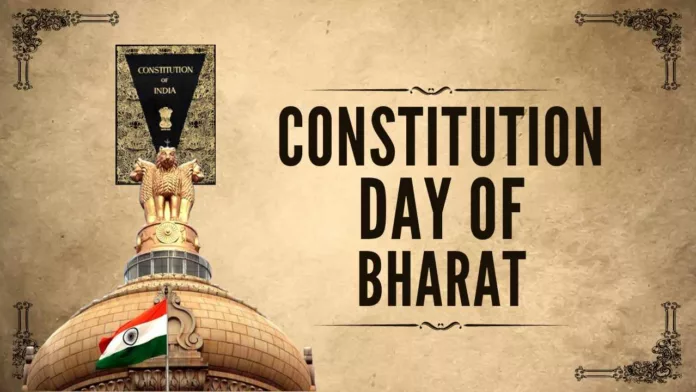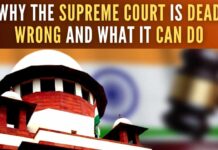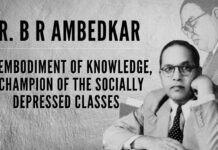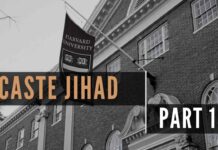
Know about the Constitution of Bharat
The Constitution of Bharat is the Supreme Body of Laws governing the nation of India. The ‘Constitution Day’, also known as the ‘Samvidhan Divas’ commemorates the adoption of the Constitution of India by the Constituent Assembly of India on the 26th day of November of 1949. The Constitution of Bharat became effective on the 26th of January 1950.
The Constituent Assembly included illustrious personages like Dr. Shyama Prasad Mukherjee, Shri. Jawaharlal Nehru and Shri. Vallabhai Patel. November 26th was commemorated as ‘National Law Day’ before 2015. It is to be noted that it was only on the 19th of November of 2015 that the Central government in power in India since 2014 formally notified November 26th as ‘Constitution Day’ in Bharat.
The aim of Constitution Day is to spread awareness about the Constitution of India to the Citizens of India. The Indian Constitution is the longest, most comprehensive, and largest written Constitution in the World.
It took around 2 years, 11 months, and 18 days to prepare the Indian Constitution. The original copy of the Constitution is handwritten. It has been preserved inside the library of Parliament.
Dr. B R Ambedkar is known as the father of the Indian Constitution. He is also known as the Architect of the Constitution of India. However, it is to be noted that it was Shri. Benegal Narsing Rau, who actually drafted the first copy of the Constitution of India. Thus, both Shri. Benegal Narsing Rau and Dr. B R Ambedkar are the Joint Architects of the Constitution of Bharat, that is India. Dr. B R Ambedkar was the Chairman of the Drafting Committee of the Constitution of India.
Thus, we must not fail to acknowledge that it was Shri. Benegal Narsing Rau, who drafted the Constitution of India as we commemorate ‘Constitution Day’. The Drafting Committee of seven members chose Dr. Ambedkar as the Chairman of the Drafting Committee. In other words, it was Dr. Ambedkar along with the six other members of the Drafting Committee, who made the corrections, additions, deletions, and modifications to the draft of the Constitution given by Shri. Benegal Narsing Rau after taking inputs from legal luminaries and the common people. Thus, the draft of the Constitution prepared by Sir Benegal Narsing Rau was subject to multiple revisions and was presented in its final form by Dr. B R Ambedkar before the Constituent Assembly on the 15th of November 1948.
It was Benegal Narsing Rau, who was the adviser to the Constituent Assembly, who prepared the first draft of the Constitution of India, all by himself. Sir Benegal Narsing Rau travelled to the U.S.A., Canada, U.K., and Ireland as part of his elaborate efforts to incorporate the best laws in various constitutions in the Indian Constitution. He consulted many scholars and legal luminaries during his sojourn abroad before setting out to draft the Constitution of India. He submitted his first draft of the Indian Constitution to the Drafting Committee by February 1948. This draft was subject to multiple debates and revisions leading to its adoption by the Constituent Assembly under the convincing and brilliant chairmanship of the Drafting Committee, Dr. B R Ambedkar.
Thus, although B N Rau was not a member of The Constituent Assembly, he was in fact, the main Architect of the Constitution of India as it was he, who came up with the first draft of the Constitution of Bharat.
Benegal Narsing Rau was an Indian Civil Service Officer and served as a Judge of the Permanent Court of International Justice. Sir Benegal was known for his tremendous knowledge of the law and different Constitutions of the World. He was also revered for his sense of justice and impartiality. It is high time to remember, recognize, acknowledge, and appreciate the contribution of Sir Benegal to the Indian Constitution alongside the illustrious Shri. Dr. Baba Saheb Ambedkar. Both of them deserve equal love and reverence as the dream draft of Sir Benegal Narsing Rau became a reality because of the Drafting Committee under the Epitome of Knowledge, Dr. B R Ambedkar.
The Constitution of India is based on the Government of India Act of 1935. Every page of the original Constitution has a gold leaf frame and the opening page of every chapter has some artwork.
It is to be noted that although the Constitution of India was adopted by the Constituent Assembly consisting of distinguished personages – the Constituent Assembly itself was not fully directly elected by the people.
The source of the Constitution as given in the preamble is the people of Bharat. The preamble clearly states that ‘We, The People of India’ have resolved to constitute India into a sovereign Democratic Republic’.
It is the Constitution (42nd Amendment) Act of 1976 that inserted the word, ‘secular’ in the preamble to the Constitution. There is no universally agreed definition of ‘secularism’. The common element is the absence of state-favored religion.
The people of Bharat can continue to be governed by the Constitution of India as long as the provisions of the Constitution are deemed to be fair and acceptable to them while promoting their dreams and aspirations. However, there is nothing to prevent The Constitution of India from being rewritten or even replaced entirely to suit the requirements of the citizens of Bharat to live in today’s fast-paced and changing world of technology, local and world affairs.
There were representatives from different provinces and princely states in the Constituent Assembly. Roughly, there was 1 seat for every ten lakhs population. The total membership of the Constituent Assembly was 389 of which 296 were representatives of British India and 93 represented the Princely States. There was representation from every class and community of people – Hindus, Muslims, Sikhs, Parsis, Christians, SCs, STs and women.
The members of the Constituent Assembly met for the first time on the 9th of December 1946. However, the Muslim League boycotted this first meeting of the Constituent Assembly.
The Drafting Committee of the Constitution of India was the most important committee of the Constituent Assembly. The Drafting Committee was formed on the 29th of August 1947. It had seven members. Dr. B R Ambedkar was made the chairman of the Drafting Committee. The seven members of the Drafting Committee were Dr. B R Ambedkar, Dr. K M Munshi, Syed Muhammad Saadullah, N Madhava Rau, Alladi Krishnaswamy Ayyar, N Gopalaswami Ayyangar, and T T Krishnamacharya.
A period of 8 months was given to the people for their suggestions, criticisms, and modifications. They were incorporated in the Constitution. Later, Dr. B R Ambedkar made the 2nd draft presentation in October 1948. On the 15th of November 1948, Dr. B R Ambedkar made the presentation of the final form of the Constitution of Bharat before the Constituent Assembly. The Constitution of India was finally adopted on the 26th of November of 1949 – now celebrated as ‘Constitution Day’ and came into effect from the 26th of January – now celebrated as ‘Republic Day’.
There has been a long-standing debate about whether ‘India’ or ‘Bharat’ should be adopted as the name of our nation. Article 1 of the Constitution states that – ‘India, that is Bharat, shall be a Union of States.’ Many scholars and the common people of Bharat are saying that it should have been – ‘Bharat, that is known as India, shall be a Union of States’.
On September 18, 1949, there was an intense debate among the members of the Constituent Assembly about the name that India ought to be given.
Shri. Kamalapati Tripathi of the Constituent Assembly succinctly said – ‘When a country is in bondage, it loses its soul. During its slavery for one thousand years, our country too lost everything. We lost our culture, we lost our history, we lost our prestige, we lost our humanity, we lost our self-respect, we lost our soul and indeed, we lost our form and name.’
The timing of the taking up of the issue of the name of Bharat for discussion in the Constituent Assembly is unfortunate given the nature of the painful partition. India is a name of comparatively recent origin (some hundreds of years old). The name ‘India’ has little cultural or geographical context. On the other hand, the term ‘Bharat’ has massive cultural and geographical connotations and has been used since times immemorial to refer to our nation’s subcontinent.’ Bharat’ is the indicator of our motherland’s true traditions, languages, cultures, and polities. It is a recorded fact that Emperor Bharata, the son of King Dushyanth and Queen Shakunthala (daughter of Sage Vishwamitra) ruled over a great area in ancient Bharat that corresponds to modern Bharat and the subcontinent. So, ‘Bharat’ represents the original history and culture of India. It represents the Sanatan Dharma traditions of the Bharatiya people since time immemorial.
The original document of the Constitution of India has a beautiful sketch of Bhagawan Shri. Rama, Mata Sita and Shri. Lakshmana returning to Ayodhya after defeating the demon king, Ravana. This picture is seen at the beginning of the chapter related to fundamental rights. The Constitution of Bharat appears to have the blessings of Bhagawan Shri. Rama.
Bhagawan Shri. Ram is the true guardian of people’s rights and both Shri. Benegal Narsing Rau and Dr. B R Ambedkar, the joint Architects of our Constitution seem to be aware of this. In our nation, Rama Rajya, or the reign of Bhagwan Shri. Rama is considered to be the gold standard or role model in governance. Thus, it is considered the paradigm of good governance by the people of Bharat. Bhagawan Shri Ram did not practice caste discrimination and was kind to even his enemies. He possessed all the virtuous qualities of a benevolent and powerful ruler.
The terms ‘socialist’ and ‘secular’ were not part of the original preamble and they were inserted through the 42nd amendment to the Constitution in 1976 during the draconian Emergency times. The amendment is morally untenable.
The original copy of the Constitution of Bharat has vivid artwork showcasing the rich artistic and cultural inheritance of Bharat. There are artworks showcasing the Indus Valley Civilization, the Vedic Gurukula System, and scenes from the Ramayana among others. The artwork has been done by illustrious artists like Nandalal Bose and Beohar Rammanohar Sinha.
The original preamble page was designed by Beohar Rammanohar Sinha of Jabalpur. The preamble page has Sinha’s short signature, ‘Ram’ in the Devanagari script in the lower-right corner. Thus, the original preamble has the blessings of Bhagawan Ram.
Till now, around 109 amendments to the Constitution have been brought about.
The Preamble became an integral part of the Constitution vide the judgment of the Keshavananda Bharathi case of 1973. Again, in the 1995 case of the Union government vs LIC of India, the Supreme Court held that the preamble is an integral part of the Constitution.
Another unique feature of the Constitution is the calligraphy in the original Constitution. The calligraphy was by Prem Behari Narain Raizada.
Currently, the original copy of the Constitution is kept in a special helium-filled case in the library of the Parliament of Bharat.
The main fallacy of Indian polity is the current divide between religion and polity. In traditions worldwide, the political head and the religious head are one and the same. A good example is the Pope, who is both the religious and political head of Vatican City State.
The king or leader is deemed to have divine rights to rule over the people since time immemorial. There is nothing wrong with taking a cue from the past.
Note:
1. Text in Blue points to additional data on the topic.
2. The views expressed here are those of the author and do not necessarily represent or reflect the views of PGurus.
For all the latest updates, download PGurus App.
- Shaheed Diwas: Remembering Bhagat Singh, Rajguru, Sukhdev on Martyr’s Day - March 23, 2024
- Chhatrapati Shivaji Maharaj – The unparalleled visionary leader - February 19, 2024
- The Constitution Day of Bharat - November 26, 2023










